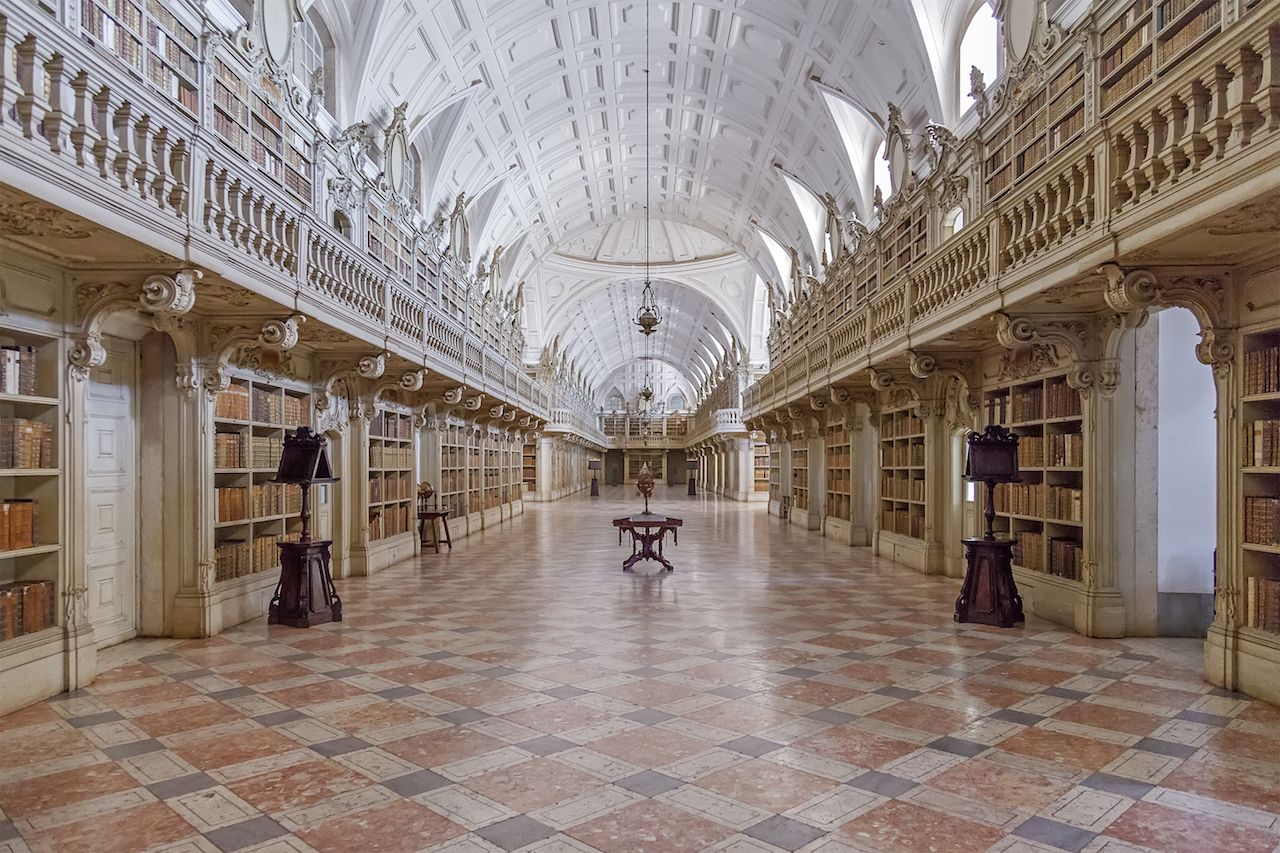Mafra, Mafra, Portugal
Photo: StockPhotosAr/Shutterstock
Located within the Palace of the Royal Building of Mafra, a cultural heritage site on the UNESCO tentative list, the Monastic-Royal Library is considered one of the most important European libraries as it contains a rare collection of about 30,000 volumes dating from the 15th to the 19th century, as well as incunabula (books printed between 1455 and 1501).
Not only does the 18th-century room host precious books, but its interior decor is also gorgeous. The very large library (about 278 feet long and 31 feet wide) with barrel vault ceilings was built in the shape of a cross, and its floor is covered in multi-colored tiles.
While most libraries go to great lengths to keep animals out, the Mafra National Palace Library actually invites them in. At night, bats are released inside the library to feed on book-eating pests that may damage the rare volumes.
According to the official website, “The Library is open to researchers, historians or scholars, whose object of study justifies the access to this collection,” but you can see the library if you take a tour of the palace.
2. Strahov Monastery Library, Prague, Czech Republic
Photo: Maciej Bledowski/Shutterstock
The Strahov Monastery Library is comprised of three rooms: the Theological Hall, the Philosophical Hall, and the Cabinet of Curiosity, all of which are stunners and contain invaluable volumes. The Theological Hall stores 18,000 volumes, most of which are different editions of the Bible or parts of the Bible in many languages, and the Philosophical Hall has 42,000 volumes on the topics of philosophy and the sciences.
Both the Theological and the Philosophical Halls are intricately decorated in a Baroque style with religiously inspired frescoes, stucco work, beautiful wooden shelves, and parquet. The Cabinet of Curiosities contains books, as well as glass cases displaying natural science collections, including the remains of a Dodo; archeological findings; and military exhibits. Located in the Strahov Monastery, the Strahov Libraryis easy to access during any visit to Prague and is open daily. Entry cost is $5.
3. Stockholm City Library, Stockholm, Sweden
Photo: Thorir Ingvarsson/Shutterstock
The City Library in Stockholm may look very modern, but it was actually built almost 100 years ago, between 1918 and 1927, by Gunnar Asplund, a world-famous Swedish architect. The outside of the building is simple enough (a cubic base topped with a cylinder) that it does not necessarily catch the eye of unsuspecting out-of-towners, but those who make it inside get rewarded for their curiosity by a stunning temple of culture.
Walk in and take the stairs all the way to the cylindrical part that is lined with tiered bookshelves, and you’ll understand the appeal instantly. You can go all the way up to the top bookshelves and admire this beautiful room from above. Perhaps the best part of this library is that it’s relatively unknown to tourists, so you can visit without having to deal with hordes of people snapping photos. There’s no entry fee to get in, but because it is a functioning library, you’ll have to be silent during your visit.
4. The Old Library at Trinity College, Dublin, Ireland
Photo: STLJB/Shutterstock
Trinity College’s Old Library might be most famous for housing the Book of Kells, the ninth-century illuminated Gospel manuscript that is considered one of Ireland’s national treasures, but there’s much more to this library than one ancient (albeit beautiful and incredibly rare) book. The Long Room of the Old Library, the most famous spot in Trinity College, is located upstairs from the exhibition room where the Book of Kells is displayed. It is a superb room filled with oak bookcases containing 200,000 of the library’s oldest books that seems to stretch for miles under an arched ceiling.
A visit to the Old Library and the exhibition of the Book of Kells is short and involves a fee (unless you know a Trinity College student who would be willing to accompany you and show their student card for you to get in). Once on the college’s grounds, make sure to explore the rest of the beautiful campus that is smack dab in the heart of the city.
5. Admont Abbey Library, Admont, Austria
Photo: Nat S. Retsu/Shutterstock
The Admont Abbey Library, built in 1776 in a seriously overwhelming European Baroque style, is the largest abbey library in the world. The library’s seven cupolas are decorated with stunning frescoes by Bartolomeo Altomonte. Stored below are about 70,000 volumes (the Abbey owns nearly 200,000 books in total) among limewood carvings by Josef Stammel, intricate columns, and a striking white and gold aesthetic. In 1865, a fire consumed almost the entire monastery, with the exception of the stunning library and its beautiful and rare volumes — phew! The Admont Abbey is also home to several museums that are worth checking out. The library is open to the public (with or without a guided tour) and is barrier-free.
6. The Boston Athenaeum, Boston, US
Photo: Boston Athenæum/Facebook
Built in 1807, the Boston Athenaeum is among the oldest and most distinguished independent libraries and cultural institutions in the United States. It added an art gallery in 1827, began running yearly exhibitions of American and European art, and by the mid-1800s found itself not only at the center of Boston’s culture scene but also one of the largest libraries in the US. Overlooking the Granary Burying Ground, a 17th-century cemetery, it currently houses over half a million volumes, many of which focus on Boston history. It also hosts an exhibition program, lectures, and even concerts, and in 1966, it was designated as a National Historic Landmark. The Athenaeum is a membership-only library with member fees starting at $220 per year, but it’s open for the public to visit or take a tour.
7. St. Peter-in-the-East, Oxford, UK
Photo: St Edmund Hall, University of Oxford/Facebook
An entire book could be written on the libraries of Oxford — the university city has over 100 libraries, making it the largest library system in the UK. The university’s main library, the Bodleian, is undoubtedly its most famous, but there are many other smaller libraries worth visiting. One of these is the library of St. Edmund Hall college, which is housed in the 12th-century church of St Peter-in-the-East, one of the oldest churches in the city of Oxford. The church was converted into a library in 1970, but the renovation process kept the integrity of the church intact — There is even a crypt below and a graveyard outside, but you won’t find any books there. The Library holds approximately 40,000 volumes. Outsider access to St. Peter-in-the-East is only allowed during school vacation periods. 







No comments:
Post a Comment